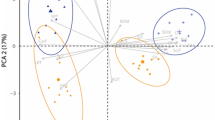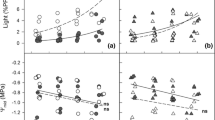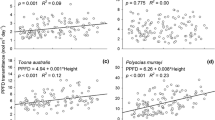Abstract
The mechanisms for species-specific growth responses to changes in atmospheric CO2 concentration within narrow ecological groups of species, such as shade-tolerant, late-successional trees, have rarely been addressed and are not well understood. In this study the underlying functional traits for interspecific variation in the biomass response to elevated CO2 were explored for seedlings of five late-successional temperate forest tree species (Fagus sylvatica, Acer pseudoplatanus, Quercus robur, Taxus baccata, Abies alba). The seedlings were grown in the natural forest understorey in very low and low light microsites (an average of 1.3% and 3.4% full sun in this experiment), and were exposed to either current ambient CO2 concentrations, 500, or 660 µl CO2 l–1 in 36 open-top chambers (OTC) over two growing seasons. Even across the narrow range of successional status and shade tolerance, the study species varied greatly in photosynthesis, light compensation point, leaf dark respiration (R d), leaf nitrogen concentration, specific leaf area (SLA), leaf area ratio (LAR), and biomass allocation among different plant parts, and showed distinct responses to CO2 in these traits. No single species combined all characteristics traditionally considered as adaptive to low light conditions. At very low light, the CO2 stimulation of seedling biomass was related to increased LAR and decreased R d, responses that were observed only in Fagus and Taxus. At slightly higher light levels, interspecific differences in the biomass response to elevated CO2 were reversed and correlated best with leaf photosynthesis. The data provided here contribute to a mechanistic process-based understanding of distinct response patterns in co-occurring tree species to elevated CO2 in natural deep shade. I conclude that the high variation in physiological and morphological traits among late-successional species, and the consequences for their responses to slight changes in resource availability, have previously been underestimated. The commonly used broad definitions of functional groups of species may not be sufficient for the understanding of recruitment success and dynamic changes in species composition of old-growth forests in response to rising concentrations of atmospheric CO2.
Similar content being viewed by others
Author information
Authors and Affiliations
Additional information
Electronic Publication
Rights and permissions
About this article
Cite this article
Hättenschwiler, S. Tree seedling growth in natural deep shade: functional traits related to interspecific variation in response to elevated CO2 . Oecologia 129, 31–42 (2001). https://doi.org/10.1007/s004420100699
Received:
Accepted:
Published:
Issue Date:
DOI: https://doi.org/10.1007/s004420100699




